Recycled Aggregate Concrete: Effect of Supplementary Cementitious Materials and Potential for Supporting Sustainable Construction
Abstract
1. Introduction
2. Review of Recycled Aggregate and Concrete Properties
3. Experimental Programme
3.1. Materials and Mix Proportions
3.2. Sample Preparation and Curing
3.3. Water Absorption, Porosity and Density
3.4. Mechanical Property Testing
3.5. Durability Testing
4. Results and Discussion
4.1. Slump of Fresh Concrete
4.2. Density, Porosity and Water Absorption of Concrete
4.3. Compressive Strength of Concrete
4.4. Modulus of Elasticity and Flexural Tensile Strength
4.4.1. Prediction of Flexural Tensile Strength
4.5. Rapid Chloride Permeability Test
4.6. Drying Shrinkage
4.7. Equivalent Carbon Emissions
5. Influence of SCMs
6. Concluding Remarks
- The incorporation of recycled coarse aggregate resulted in measurable reductions in compressive strength, flexural tensile strength, and elastic modulus. It also led to increased water absorption, porosity, chloride ion permeability, and drying shrinkage, indicating a lower overall performance compared to the reference PC mix containing virgin aggregates and Portland cement as the main binder.
- The partial replacement of Portland cement with GGBS and/or silica fume significantly enhanced the physical and mechanical properties of concrete containing virgin coarse aggregates. Improvements were observed in compressive strength, tensile strength, elastic modulus, and reductions in porosity and water absorption. These enhancements are attributed to the pozzolanic activity of the SCMs and the resulting refinement of the concrete micropore structure.
- The inclusion of SCMs in recycled aggregate concrete did not yield notable improvements in mechanical properties. This is likely due to the predominant influence of residual mortar adhered to the recycled aggregate particles and the inherently higher porosity of the recycled aggregates. Nevertheless, the combined use of GGBS and silica fume (ternary blend) exhibited significant improvements, including up to 80% reduction in chloride permeability and 36% reduction in drying shrinkage.
- The recycled aggregates used in this study, sourced locally within the UAE, met the minimum requirements specified in various international standards and exhibited performance characteristics consistent with those reported in previous studies. Their increased use in general concreting applications should therefore be encouraged to promote sustainable development initiatives across the Middle East and beyond. The combined use of recycled aggregate and SCMs is particularly recommended for applications where long-term durability is of primary importance, such as in chloride-rich environments.
- The carbon emission of concrete is closely linked to the quantity of Portland cement used. The most significant reduction in CO2e emissions (exceeding 40%) was achieved through the combined use of 50% GGBS, 10% silica fume, and 100% recycled aggregate. This optimised mix elevated the sustainable classification of the concrete from Class F to Class A (Green) on the ICE embodied carbon ranking scale, underscoring its potential as a low-carbon, high-performance material for future infrastructure development.
- Owing to the comparable mechanical performance, significant durability enhancement from the ternary SCM blend, reduced embodied carbon, and improved shrinkage control, the developed recycled aggregate concrete mix is deemed suitable to support durable and sustainable construction practice in the UAE. Potential applications include both cast in situ and precast elements in marine-exposed infrastructure, where chloride-induced reinforcement corrosion is a major concern. The developed mix may also be applicable for general urban infrastructure, including foundations and other underground structures, subject to further validation under relevant exposure conditions.
Author Contributions
Funding
Institutional Review Board Statement
Informed Consent Statement
Data Availability Statement
Acknowledgments
Conflicts of Interest
References
- Construction Waste Market Global Industry Analysis, Size, Share, Growth, Trend and Forecast 2017–2025. 2023. Available online: https://www.transparencymarketresearch.com/construction-waste-market.html (accessed on 12 March 2025).
- Galbenis, C.-T.; Tsimas, S. Use of Construction and Demolition Wastes as Raw Materials in Cement Clinker Production. China Particuology 2006, 4, 83–85. [Google Scholar] [CrossRef]
- Eurostat. Generation of Waste by Waste Category, Hazardousness and NACE. Available online: https://ec.europa.eu/eurostat/databrowser/view/env_wasgen/default/table?lang=en (accessed on 12 March 2025).
- Institute for Environment and Sustainability (Joint Research Centre). Supporting Environmentally Sound Decisions for Construction and Demolition (C&D) Waste Management—A Practical Guide to Life Cycle Thinking (LCT) and Life Cycle Assessment (LCA); Publications Office of the European Union: Luxembourg, 2011. [Google Scholar]
- Mawed, M.; Al Nuaim, M.; Kashwani, G. Construction and Demolition Waste Management in the UAE: Application and Obstacles. Int. J. GEOMATE 2020, 18, 235–245. [Google Scholar] [CrossRef]
- MEED. Removing Waste from UAE Construction. 2020. Available online: https://www.meedmashreqindustryinsight.com/wp-content/uploads/2020/05/V5_MashreqConstruction_Report-10.pdf (accessed on 15 May 2024).
- Batikha, M.; Ali, S.T.M.; Rostami, A.; Kurtayev, M. Using Recycled Coarse Aggregate and Ceramic Waste to Produce Sustainable Economic Concrete. Int. J. Sustain. Eng. 2021, 14, 785–799. [Google Scholar] [CrossRef]
- Dubai Municipality Green Building Regulations & Specifications. 2014. Available online: https://www.dewa.gov.ae/~/media/Files/Consultants%20and%20Contractors/Green%20Building/Greenbuilding_Eng.ashx (accessed on 15 February 2024).
- Ras Al Kaimah Municipality. Ras Al Khaimah Green Building Regulations. 2018. Available online: https://mun.rak.ae/Documents/EER/Barjeel%20-%20Green%20Building%20Regulations.pdf (accessed on 15 February 2024).
- CDE. Unlocking Value from C&D Waste in the Middle East and Africa. 2023. Available online: https://www.cdegroup.com/about/news-events/latest-news/unlocking-c-d-waste-middle-east-africa (accessed on 12 December 2023).
- Tadweer Abu Dhabi Waste Management Centre. Recycling Construction and Demolition Waste. Available online: https://globalwastetozero.com/ (accessed on 12 December 2023).
- Bee’ah Recycling. Available online: https://www.beeahgroup.com/services/beeah-recycling/ (accessed on 12 December 2023).
- Bagchi, A. Tadweer Recycles 1.9 Millions Tons of Construction and Demolition Waste in 2020. Me Construction News. 2022. Available online: https://meconstructionnews.com/46704/tadweer-recycles-1-9-millions-tons-of-construction-and-demolition-waste-in-2020 (accessed on 15 February 2024).
- Silva, R.V.; de Brito, J.; Dhir, R.K. Availability and Processing of Recycled Aggregates within the Construction and Demolition Supply Chain: A Review. J. Clean. Prod. 2017, 143, 598–614. [Google Scholar] [CrossRef]
- Xie, T.; Gholampour, A.; Ozbakkaloglu, T. Toward the Development of Sustainable Concretes with Recycled Concrete Aggregates: Comprehensive Review of Studies on Mechanical Properties. J. Mater. Civ. Eng. 2018, 30, 04018211. [Google Scholar] [CrossRef]
- Limbachiya, M.C.; Leelawat, T.; Dhir, R.K. Use of Recycled Concrete Aggregate in High-Strength Concrete. Mater. Struct. 2000, 33, 574–580. [Google Scholar] [CrossRef]
- Xie, J.; Li, J.; Lu, Z.; Li, Z.; Fang, C.; Huang, L.; Li, L. Combination Effects of Rubber and Silica Fume on the Fracture Behaviour of Steel-Fibre Recycled Aggregate Concrete. Constr. Build. Mater. 2019, 203, 164–173. [Google Scholar] [CrossRef]
- Xie, J.; Wang, J.; Rao, R.; Wang, C.; Fang, C. Effects of Combined Usage of GGBS and Fly Ash on Workability and Mechanical Properties of Alkali Activated Geopolymer Concrete with Recycled Aggregate. Compos. Part B Eng. 2019, 164, 179–190. [Google Scholar] [CrossRef]
- Ozbakkaloglu, T.; Gholampour, A.; Xie, T. Mechanical and Durability Properties of Recycled Aggregate Concrete: Effect of Recycled Aggregate Properties and Content. J. Mater. Civ. Eng. 2018, 30, 04017275. [Google Scholar] [CrossRef]
- Xiao, J. Chapter 6: Strength of Recycled Aggregate Concrete. In Recycled Aggregate Concrete Structures; Xiao, J., Ed.; Springer: Berlin/Heidelberg, Germany, 2018; pp. 65–97. ISBN 978-3-662-53987-3. [Google Scholar] [CrossRef]
- Rao, M.C.; Bhattacharyya, S.K.; Barai, S.V. Behaviour of Recycled Aggregate Concrete under Drop Weight Impact Load. Constr. Build. Mater. 2011, 25, 69–80. [Google Scholar] [CrossRef]
- Xiao, J. Chapter 4: Recycled Aggregate Concrete. In Recycled Aggregate Concrete Structures; Xiao, J., Ed.; Springer: Berlin/Heidelberg, Germany, 2018; pp. 65–98. ISBN 978-3-662-53987-3. [Google Scholar] [CrossRef]
- Çakır, Ö.; Sofyanlı, Ö.Ö. Influence of Silica Fume on Mechanical and Physical Properties of Recycled Aggregate Concrete. HBRC J. 2015, 11, 157–166. [Google Scholar] [CrossRef]
- Barbudo, A.; de Brito, J.; Evangelista, L.; Bravo, M.; Agrela, F. Influence of Water-Reducing Admixtures on the Mechanical Performance of Recycled Concrete. J. Clean. Prod. 2013, 59, 93–98. [Google Scholar] [CrossRef]
- González-Fonteboa, B.; Martínez-Abella, F.; Eiras-López, J.; Seara-Paz, S. Effect of Recycled Coarse Aggregate on Damage of Recycled Concrete. Mater. Struct. 2011, 44, 1759–1771. [Google Scholar] [CrossRef]
- Kou, S.C.; Poon, C.-S. Mechanical Properties of 5-Year-Old Concrete Prepared with Recycled Aggregates Obtained from Three Different Sources. Mag. Concr. Res. 2008, 60, 57–64. [Google Scholar] [CrossRef]
- Ajdukiewicz, A.B.; Kliszczewicz, A.T. Comparative Tests of Beams and Columns Made of Recycled Aggregate Concrete and Natural Aggregate Concrete. J. Adv. Concr. Technol. 2007, 5, 259–273. [Google Scholar] [CrossRef]
- Gómez-Soberón, J.M. Porosity of Recycled Concrete with Substitution of Recycled Concrete Aggregate. Cem. Concr. Res. 2002, 32, 1301–1311. [Google Scholar] [CrossRef]
- Poon, C.; Shui, Z.; Lam, L. Effect of Microstructure of ITZ on Compressive Strength of Concrete Prepared with Recycled Aggregates. Constr. Build. Mater. 2004, 18, 461–468. [Google Scholar] [CrossRef]
- Etxeberria, M.; Vázquez, E.; Marí, A.; Barra, M. Influence of Amount of Recycled Coarse Aggregates and Production Process on Properties of Recycled Aggregate Concrete. Cem. Concr. Res. 2007, 37, 735–742. [Google Scholar] [CrossRef]
- Kou, S.C.; Poon, C.S.; Chan, D. Influence of Fly Ash as Cement Replacement on the Properties of Recycled Aggregate Concrete. J. Mater. Civ. Eng. 2007, 19, 709–717. [Google Scholar] [CrossRef]
- Rahal, K. Mechanical Properties of Concrete with Recycled Coarse Aggregate. Build. Environ. 2007, 42, 407–415. [Google Scholar] [CrossRef]
- Casuccio, M.; Torrijos, M.C.; Giaccio, G.; Zerbino, R. Failure Mechanism of Recycled Aggregate Concrete. Constr. Build. Mater. 2008, 22, 1500–1506. [Google Scholar] [CrossRef]
- Yang, K.-H.; Chung, H.-S.; Ashour, A.F. Influence of Type and Replacement Level of Recycled Aggregates on Concrete Properties. ACI Mater. J. 2008, 105, 289–296. [Google Scholar] [CrossRef] [PubMed]
- Domingo-Cabo, A.; Lázaro, C.; López-Gayarre, F.; Serrano-López, M.A.; Serna, P.; Castaño-Tabares, J.O. Creep and Shrinkage of Recycled Aggregate Concrete. Constr. Build. Mater. 2009, 23, 2545–2553. [Google Scholar] [CrossRef]
- Malešev, M.; Radonjanin, V.; Marinković, S. Recycled Concrete as Aggregate for Structural Concrete Production. Sustainability 2010, 2, 1204–1225. [Google Scholar] [CrossRef]
- Fathifazl, G.; Ghani Razaqpur, A.; Burkan Isgor, O.; Abbas, A.; Fournier, B.; Foo, S. Creep and Drying Shrinkage Characteristics of Concrete Produced with Coarse Recycled Concrete Aggregate. Cem. Concr. Compos. 2011, 33, 1026–1037. [Google Scholar] [CrossRef]
- Butler, L.; West, J.S.; Tighe, S.L. Effect of Recycled Concrete Coarse Aggregate from Multiple Sources on the Hardened Properties of Concrete with Equivalent Compressive Strength. Constr. Build. Mater. 2013, 47, 1292–1301. [Google Scholar] [CrossRef]
- Andreu, G.; Miren, E. Experimental Analysis of Properties of High Performance Recycled Aggregate Concrete. Constr. Build. Mater. 2014, 52, 227–235. [Google Scholar] [CrossRef]
- Beltrán, M.G.; Barbudo, A.; Agrela, F.; Galvín, A.P.; Jiménez, J.R. Effect of Cement Addition on the Properties of Recycled Concretes to Reach Control Concretes Strengths. J. Clean. Prod. 2014, 79, 124–133. [Google Scholar] [CrossRef]
- Duan, Z.H.; Poon, C.S. Properties of Recycled Aggregate Concrete Made with Recycled Aggregates with Different Amounts of Old Adhered Mortars. Mater. Des. 2014, 58, 19–29. [Google Scholar] [CrossRef]
- Pedro, D.; de Brito, J.; Evangelista, L. Performance of Concrete Made with Aggregates Recycled from Precasting Industry Waste: Influence of the Crushing Process. Mater. Struct. 2015, 48, 3965–3978. [Google Scholar] [CrossRef]
- Lotfi, S.; Eggimann, M.; Wagner, E.; Mróz, R.; Deja, J. Performance of Recycled Aggregate Concrete Based on a New Concrete Recycling Technology. Constr. Build. Mater. 2015, 95, 243–256. [Google Scholar] [CrossRef]
- Adams, M.P.; Fu, T.; Cabrera, A.G.; Morales, M.; Ideker, J.H.; Isgor, O.B. Cracking Susceptibility of Concrete Made with Coarse Recycled Concrete Aggregates. Constr. Build. Mater. 2016, 102, 802–810. [Google Scholar] [CrossRef]
- Montero, J.; Laserna, S. Influence of Effective Mixing Water in Recycled Concrete. Constr. Build. Mater. 2017, 132, 343–352. [Google Scholar] [CrossRef]
- Tam, V.W.Y.; Tam, C.M. Assessment of Durability of Recycled Aggregate Concrete Produced by Two-Stage Mixing Approach. J. Mater. Sci. 2007, 42, 3592–3602. [Google Scholar] [CrossRef]
- Levy, S.M.; Helene, P. Durability of Recycled Aggregates Concrete: A Safe Way to Sustainable Development. Cem. Concr. Res. 2004, 34, 1975–1980. [Google Scholar] [CrossRef]
- Specifications for Concrete with Recycled Aggregates. Mater. Struct. 1994, 27, 557–559. [CrossRef]
- CUR-VB. CUR Metselwerkpuingranulaat Als Toeslagsmateriaal Voor Beton; Aanbeveling 5; CUR-VB: Gouda, The Netherlands, 1994. (In Dutch) [Google Scholar]
- Ministerio de Fomento. EHE Instrucción de Hormigón Structural; Ministerio de Fomento: Madrid, Spain, 2001. (In Spanish) [Google Scholar]
- JSA. JIS A 5021: 2005 Recycled Aggregate for Concrete-Class H; JSA: Tokyo, Japan, 2005. (In Japanese) [Google Scholar]
- WBTC No. 12/2002 Specifications Facilitating the Use of Recycled Aggregates; Works Bureau Technical Circular: Hong Kong, China, 2002.
- Vintimilla, C.; Etxeberria, M. Limiting the Maximum Fine and Coarse Recycled Aggregates-Type A Used in Structural Concrete. Constr. Build. Mater. 2023, 380, 131273. [Google Scholar] [CrossRef]
- Jiménez, L.F.; Domínguez, J.A.; Vega-Azamar, R.E. Carbon Footprint of Recycled Aggregate Concrete. Adv. Civ. Eng. 2018, 2018, 7949741. [Google Scholar] [CrossRef]
- Etxeberria, M.; Marí, A.R.; Vázquez, E. Recycled Aggregate Concrete as Structural Material. Mater. Struct. 2007, 40, 529–541. [Google Scholar] [CrossRef]
- Kou, S.C.; Poon, C.S.; Chan, D. Influence of Fly Ash as a Cement Addition on the Hardened Properties of Recycled Aggregate Concrete. Mater. Struct. 2008, 41, 1191–1201. [Google Scholar] [CrossRef]
- Tam, V.W.Y.; Tam, C.M. Crushed Aggregate Production from Centralized Combined and Individual Waste Sources in Hong Kong. Constr. Build. Mater. 2007, 21, 879–886. [Google Scholar] [CrossRef]
- Folino, P.; Xargay, H. Recycled Aggregate Concrete—Mechanical Behavior under Uniaxial and Triaxial Compression. Constr. Build. Mater. 2014, 56, 21–31. [Google Scholar] [CrossRef]
- Abd Elhakam, A.; Mohamed, A.E.; Awad, E. Influence of Self-Healing, Mixing Method and Adding Silica Fume on Mechanical Properties of Recycled Aggregates Concrete. Constr. Build. Mater. 2012, 35, 421–427. [Google Scholar] [CrossRef]
- Thomas, C.; Sosa, I.; Setién, J.; Polanco, J.A.; Cimentada, A.I. Evaluation of the Fatigue Behavior of Recycled Aggregate Concrete. J. Clean. Prod. 2014, 65, 397–405. [Google Scholar] [CrossRef]
- Arezoumandi, M.; Smith, A.; Volz, J.S.; Khayat, K.H. An Experimental Study on Flexural Strength of Reinforced Concrete Beams with 100% Recycled Concrete Aggregate. Eng. Struct. 2015, 88, 154–162. [Google Scholar] [CrossRef]
- Thomas, J.; Thaickavil, N.N.; Wilson, P.M. Strength and Durability of Concrete Containing Recycled Concrete Aggregates. J. Build. Eng. 2018, 19, 349–365. [Google Scholar] [CrossRef]
- Seo, T.-S.; Lee, M.-S. Experimental Study on Tensile Creep of Coarse Recycled Aggregate Concrete. Int. J. Concr. Struct. Mater. 2015, 9, 337–343. [Google Scholar] [CrossRef]
- Knaack, A.M.; Kurama, Y.C. Behavior of Reinforced Concrete Beams with Recycled Concrete Coarse Aggregates. J. Struct. Eng. 2015, 141, B4014009. [Google Scholar] [CrossRef]
- Bai, G.; Zhu, C.; Liu, C.; Liu, B. An Evaluation of the Recycled Aggregate Characteristics and the Recycled Aggregate Concrete Mechanical Properties. Constr. Build. Mater. 2020, 240, 117978. [Google Scholar] [CrossRef]
- Ghoneim, M.; Yehia, A.; Yehia, S.; Abuzaid, W. Shear Strength of Fiber Reinforced Recycled Aggregate Concrete. Materials 2020, 13, 4183. [Google Scholar] [CrossRef]
- Berndt, M.L. Properties of Sustainable Concrete Containing Fly Ash, Slag and Recycled Concrete Aggregate. Constr. Build. Mater. 2009, 23, 2606–2613. [Google Scholar] [CrossRef]
- Kou, S.C.; Poon, C.; Agrela, F. Comparisons of Natural and Recycled Aggregate Concretes Prepared with the Addition of Different Mineral Admixtures. Cem. Concr. Compos. 2011, 33, 788–795. [Google Scholar] [CrossRef]
- Çakır, Ö. Experimental Analysis of Properties of Recycled Coarse Aggregate (RCA) Concrete with Mineral Additives. Constr. Build. Mater. 2014, 68, 17–25. [Google Scholar] [CrossRef]
- Saini, M.; Goel, S. Strength and Permeability of Recycled Aggregate Concrete Containing Silica Fumes. Int. J. Innov. Res. Sci. Eng. Technol. 2016, 5, 17675–17682. [Google Scholar]
- Arora, S.; Singh, B.; Bhardwaj, B. Strength Performance of Recycled Aggregate Concretes Containing Mineral Admixtures and Their Performance Prediction through Various Modeling Techniques. J. Build. Eng. 2019, 24, 100741. [Google Scholar] [CrossRef]
- Yang, K.-H.; Jung, Y.-B.; Cho, M.-S.; Tae, S.-H. Effect of Supplementary Cementitious Materials on Reduction of CO2 Emissions from Concrete. J. Clean. Prod. 2015, 103, 774–783. [Google Scholar] [CrossRef]
- Suryanto, B.; Starrs, G.; Tambusay, A.; Clark, E.; Kim, J. Temperature Correction Protocol for In-situ Monitoring of Concrete during the Curing and Post-curing Periods: Application to Low Carbon Concrete. Cem. Concr. Compos. 2025, 164, 106224. [Google Scholar] [CrossRef]
- Mouna, Y.; Batikha, M.; Suryanto, B. Low Carbon Recycled Aggregate Concrete: Roles of Slag and Silica Fume. In Proceedings of the 8th Zero Energy Mass Custom Home International Conference 2021, Dubai, United Arab Emirates, 26–28 October 2021; ZEMCH Network: Mexico City, Mexico, 2021; pp. 1063–1074. [Google Scholar]
- BS EN 197-1:2011; Cement—Part 1: Composition, Specifications and Conformity Criteria for Common Cements. British Standards Institution: London, UK, 2011.
- BS EN 15167-1:2006; Ground Granulated Blast Furnace Slag for Use in Concrete, Mortar and Grout—Part 1: Definitions, Specifications and Conformity Criteria. British Standards Institution: London, UK, 2016.
- BS EN 13263-1:2005; Silica Fume for Concrete—Part 1: Definitions, Requirements and Conformity Criteria. British Standards Institution: London, UK, 2005.
- BS EN 12620:2002+A1:2008; Aggregates for Concrete. British Standards Institution: London, UK, 2008.
- ACI Committee 211. ACI PRC-211.1-91: Standard Practice for Selecting Proportions for Normal, Heavyweight, and Mass Concrete. American Concrete Institute’s Committee 211: Farmington Hills, MI, USA, 2002; ISBN 978-0-87031-017-1.
- ASTM International. ASTM C494 Standard Specification for Chemical Admixtures for Concrete; ASTM International: West Conshohocken, PA, USA, 2008. [Google Scholar]
- BS EN 12390-3:2019; Testing Hardened Concrete—Part 3: Compressive Strength of Test Specimens. British Standards Institution: London, UK, 2019.
- BS EN 12350-2:2019; Testing Fresh Concrete—Part 2: Slump Test. British Standards Institution: London, UK, 2019.
- BS 1881-122:2011; Testing Concrete—Method for Determination of Water Absorption. British Standards Institution: London, UK, 2011.
- RILEM Technical Committee. CPC 11.3 Absorption of Water by Concrete by Immersion under Vacuum. In RILEM Recommendations for the Testing and Use of Construction Materials; E & FN Spon: London, UK, 1994; pp. 36–37. [Google Scholar]
- BS EN 12390-7:2019; Testing Hardened Concrete. Density of Hardened Concrete. British Standards Institution: London, UK, 2019.
- ASTM International. ASTM C469-02—Standard Test Method for Static Modulus of Elasticity and Poisson’s Ratio of Concrete in Compression; ASTM Committee: West Conshohocken, PA, USA, 2006. [Google Scholar]
- UNI 11039-2:2003; Steel Fibre Reinforced Concrete—Test Method for Determination of First Crack Strength and Ductility Indexes. Ente Nazionale Italiano di Unificazione (UNI): Milano, Italy, 2003.
- ASTM International. ASTM C1202-22- Standard Test Method for Electrical Indication of Concrete’s Ability to Resist Chloride Ion Penetration; ASTM International: West Conshohocken, PA, USA, 2022. [Google Scholar]
- BS 812-120; Testing Aggregates Part 120: Method for Testing and Classifying Drying Shrinkage of Aggregates in Concrete. British Standards Institution: London, UK, 1989.
- BS 8500-1:2015; Concrete—Complementary British Standard to BS EN 206. British Standards Institution: London, UK, 2015.
- ASTM International. ASTM C143-03 Standard Test Method for Slump of Hydraulic Cement Concrete; ASTM International: West Conshohocken, PA, USA, 2003. [Google Scholar]
- Al Martini, S.; Sabouni, R.; Khartabil, A.; Wakjira, T.G.; Alam, M.S. Use of Fresh Properties to Predict Mechanical Properties of Sustainable Concrete Incorporating Recycled Concrete Aggregate. J. Sustain. Cem. Mater. 2024, 13, 1277–1288. [Google Scholar] [CrossRef]
- Danish, A.; Mosaberpanah, M.A. A Review on Recycled Concrete Aggregates (RCA) Characteristics to Promote RCA Utilization in Developing Sustainable Recycled Aggregate Concrete (RAC). Eur. J. Environ. Civ. Eng. 2022, 26, 6505–6539. [Google Scholar] [CrossRef]
- BS EN 206:2013; Concrete—Specification, Performance, Production and Conformity. British Standards Institution: London, UK, 2013.
- Zabihi, N.; Eren, O. Compressive Strength Conversion Factors of Concrete as Affected by Specimen Shape and Size. Res. J. Appl. Sci. Eng. Technol. 2014, 7, 4251–4257. [Google Scholar] [CrossRef]
- Xiao, J.; Li, J.; Zhang, C. Mechanical Properties of Recycled Aggregate Concrete under Uniaxial Loading. Cem. Concr. Res. 2005, 35, 1187–1194. [Google Scholar] [CrossRef]
- BS EN 1992-1-1:2004; Eurocode 2: Design of Concrete Structures—Part 1-1: General Rules and Rules for Buildings. British Standards Institution: London, UK, 2004.
- Kou, S.C.; Poon, C.S.; Etxeberria, M. Influence of Recycled Aggregates on Long Term Mechanical Properties and Pore Size Distribution of Concrete. Cem. Concr. Compos. 2011, 33, 286–291. [Google Scholar] [CrossRef]
- Suryanto, B.; Kim, J.; McCarter, W.J.; Starrs, G.; Aitken, M.W. Assessing the Performance and Transport Properties of Concrete Using Electrical Property Measurements. J. Adv. Concr. Technol. 2020, 18, 437–455. [Google Scholar] [CrossRef]
- Oner, A.; Akyuz, S. An Experimental Study on Optimum Usage of GGBS for the Compressive Strength of Concrete. Cem. Concr. Compos. 2007, 29, 505–514. [Google Scholar] [CrossRef]
- Dave, N.; Misra, A.K.; Srivastava, A.; Sharma, A.K.; Kaushik, S.K. Study on Quaternary Concrete Micro-Structure, Strength, Durability Considering the Influence of Multi-Factors. Constr. Build. Mater. 2017, 139, 447–457. [Google Scholar] [CrossRef]
- Singh, A.; Duan, Z.; Xiao, J.; Liu, Q. Incorporating Recycled Aggregates in Self-Compacting Concrete: A Review. J. Sustain. Cem. Mater. 2020, 9, 165–189. [Google Scholar] [CrossRef]
- Liu, Y.; Ren, P.; Garcia-Troncoso, N.; Mo, K.H.; Ling, T.-C. Roles of Enhanced ITZ in Improving the Mechanical Properties of Concrete Prepared with Different Types of Recycled Aggregates. J. Build. Eng. 2022, 60, 105197. [Google Scholar] [CrossRef]
- Munir, M.J.; Wu, Y.-F.; Kazmi, S.M.S.; Patnaikuni, I.; Zhou, Y.; Xing, F. Stress-Strain Behavior of Spirally Confined Recycled Aggregate Concrete: An Approach towards Sustainable Design. Resour. Conserv. Recycl. 2019, 146, 127–139. [Google Scholar] [CrossRef]
- Kisku, N.; Joshi, H.; Ansari, M.; Panda, S.K.; Nayak, S.; Dutta, S.C. A Critical Review and Assessment for Usage of Recycled Aggregate as Sustainable Construction Material. Constr. Build. Mater. 2017, 131, 721–740. [Google Scholar] [CrossRef]
- Saravanakumar, P.; Manoj, D.; Jagan, S. Properties of Concrete Having Treated Recycled Coarse Aggregate and Slag. Rev. La Construcción 2021, 20, 249–258. [Google Scholar] [CrossRef]
- Mathur, P.; Joshi, T.; Dave, U. Impact of Recycled Aggregates on Mechanical Properties of Concrete. Mater. Today Proc. 2023, 80, 674–680. [Google Scholar] [CrossRef]
- Xiao, J.; Li, W.; Sun, Z.; Lange, D.A.; Shah, S.P. Properties of Interfacial Transition Zones in Recycled Aggregate Concrete Tested by Nanoindentation. Cem. Concr. Compos. 2013, 37, 276–292. [Google Scholar] [CrossRef]
- Kazmi, S.M.S.; Munir, M.J.; Wu, Y.-F.; Patnaikuni, I.; Zhou, Y.; Xing, F. Influence of Different Treatment Methods on the Mechanical Behavior of Recycled Aggregate Concrete: A Comparative Study. Cem. Concr. Compos. 2019, 104, 103398. [Google Scholar] [CrossRef]
- FIB (Fédération Internationale du Béton). FIB Model Code for Concrete Structures 2013; FIB: Lausanne, Switzerland, 2010. [Google Scholar]
- ACI 318. Building Code Requirements for Structural Concrete and Commentary; American Concrete Institute: Farmington Hills, MI, USA, 2014. [Google Scholar]
- Kim, J.; McCarter, W.J.; Suryanto, B.; Nanukuttan, S.; Basheer, P.A.M.; Chrisp, T.M. Chloride Ingress into Marine Exposed Concrete: A Comparison of Empirical- and Physically- Based Models. Cem. Concr. Compos. 2016, 72, 133–145. [Google Scholar] [CrossRef]
- Ann, K.Y.; Moon, H.Y.; Kim, Y.B.; Ryou, J. Durability of Recycled Aggregate Concrete Using Pozzolanic Materials. Waste Manag. 2008, 28, 993–999. [Google Scholar] [CrossRef]
- McCarter, W.J.; Suryanto, B.; Taha, H.M.; Nanukuttan, S.; Basheer, P.M. A Testing Methodology for Performance-Based Specification. J. Struct. Integr. Maint. 2017, 2, 78–88. [Google Scholar] [CrossRef]
- Kanda, T.; Momose, H.; Imamoto, K. Shrinkage Cracking Resistance of Blast Furnace Slag Blended Cement Concrete—Influencing Factors and Enhancing Measures. J. Adv. Concr. Technol. 2015, 13, 1–14. [Google Scholar] [CrossRef]
- Wang, Q.; Geng, Y.; Wang, Y.; Zhang, H. Drying Shrinkage Model for Recycled Aggregate Concrete Accounting for the Influence of Parent Concrete. Eng. Struct. 2020, 202, 109888. [Google Scholar] [CrossRef]
- McLellan, B.C.; Williams, R.P.; Lay, J.; van Riessen, A.; Corder, G.D. Costs and Carbon Emissions for Geopolymer Pastes in Comparison to Ordinary Portland Cement. J. Clean. Prod. 2011, 19, 1080–1090. [Google Scholar] [CrossRef]
- Kajaste, R.; Hurme, M. Cement Industry Greenhouse Gas Emissions—Management Options and Abatement Cost. J. Clean. Prod. 2016, 112, 4041–4052. [Google Scholar] [CrossRef]
- Stripple, H.; Ljungkrantz, C.; Gustafsson, T.; Andersson, R. CO2 Uptake in Cement-Containing Products—Background and Calculation Models for IPCC Implementation; IVL Swedish Environmental Research Institute: Stockholm, Sweden, 2018. [Google Scholar]
- King, D. The Effect of Silica Fume on the Properties of Concrete as Defined in Concrete Society Report 74, Cementitious Materials. In Proceedings of the 37th Conference on Our World in Concrete and Structures, Singapore, 29–31 August 2012; pp. 29–31. [Google Scholar]
- Latawiec, R.; Woyciechowski, P.; Kowalski, K. Sustainable Concrete Performance—CO2-Emission. Environments 2018, 5, 27. [Google Scholar] [CrossRef]
- Marinković, S.B.; Malešev, M.; Ignjatović, I. Life Cycle Assessment (LCA) of Concrete Made Using Recycled Concrete or Natural Aggregates. In Eco-Efficient Construction and Building Materials; Elsevier: Amsterdam, The Netherlands, 2014; pp. 239–266. [Google Scholar]
- Quattrone, M.; Angulo, S.C.; John, V.M. Energy and CO2 from High Performance Recycled Aggregate Production. Resour. Conserv. Recycl. 2014, 90, 21–33. [Google Scholar] [CrossRef]
- Low Carbon Concrete Group. The Green Construction Board. Low Carbon Concrete Routemap: Setting the Agenda for a Path to Net Zero; ICE: London, UK, 2022. [Google Scholar]
- Val, D.V.; Malami, S.I.; Suryanto, B.; Muhit, I.B. Reliability-based durability requirements for RC structures made of low-carbon concretes in climate change conditions. Civ. Eng. Environ. Syst. 2025, 42, 164–189. [Google Scholar] [CrossRef]
- Malami, S.I.; Val, D.V.; Suryanto, B.; Salman, H.A.; Wang, X.H. Probabilistic approach to the sustainability assessment of reinforced concrete structures in conditions of climate change. Struct. Saf. 2024, 107, 102428. [Google Scholar] [CrossRef]
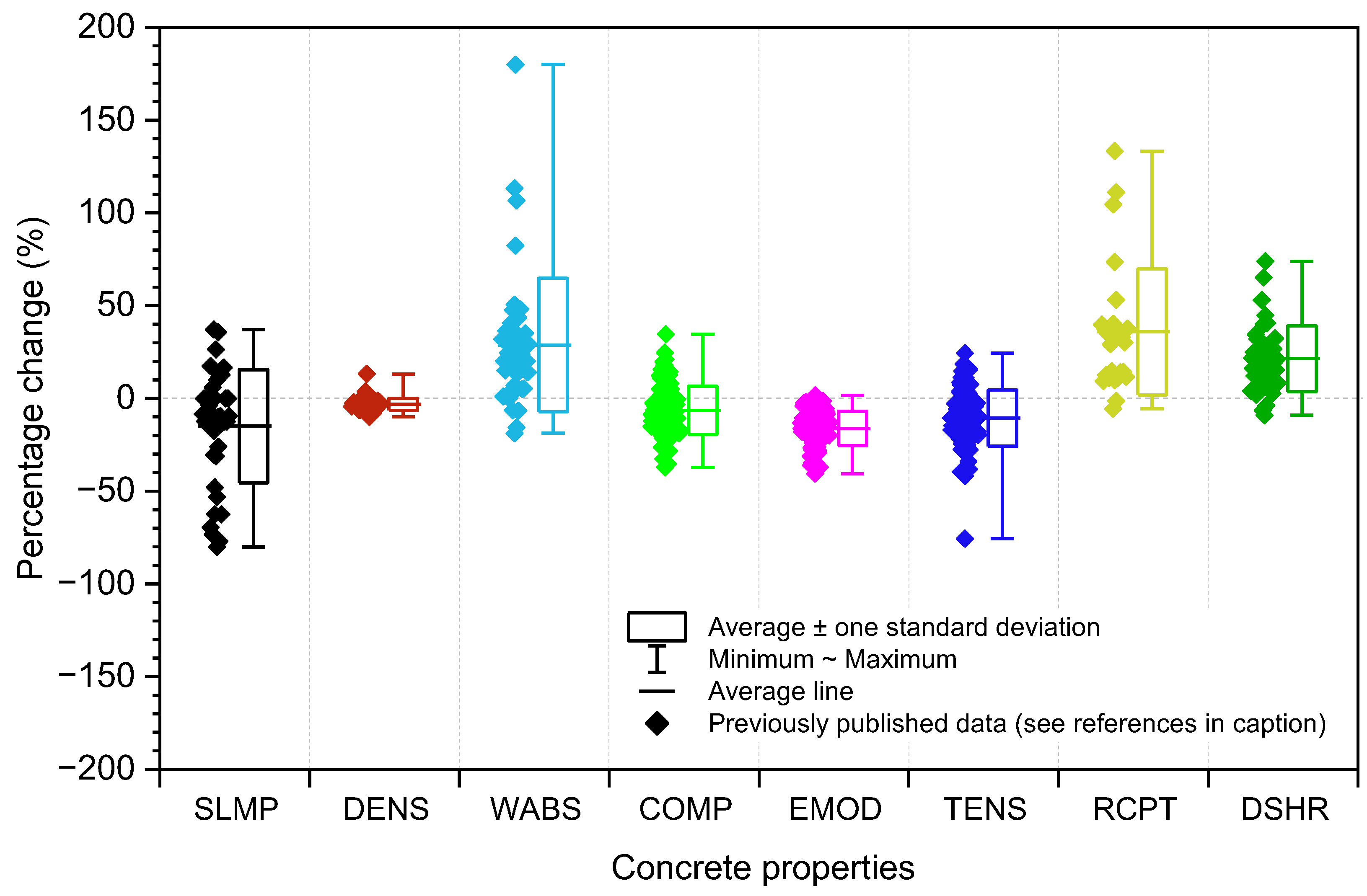
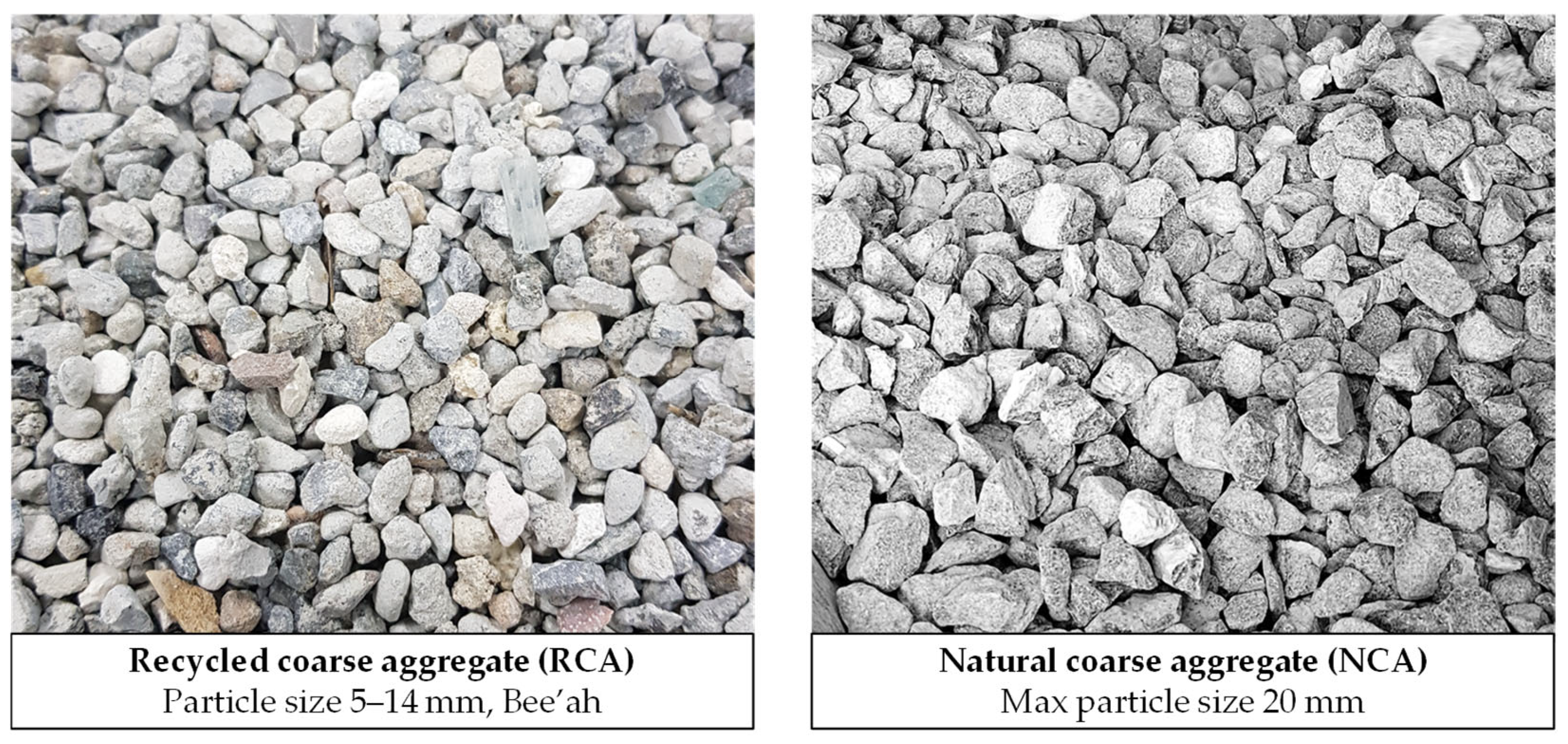
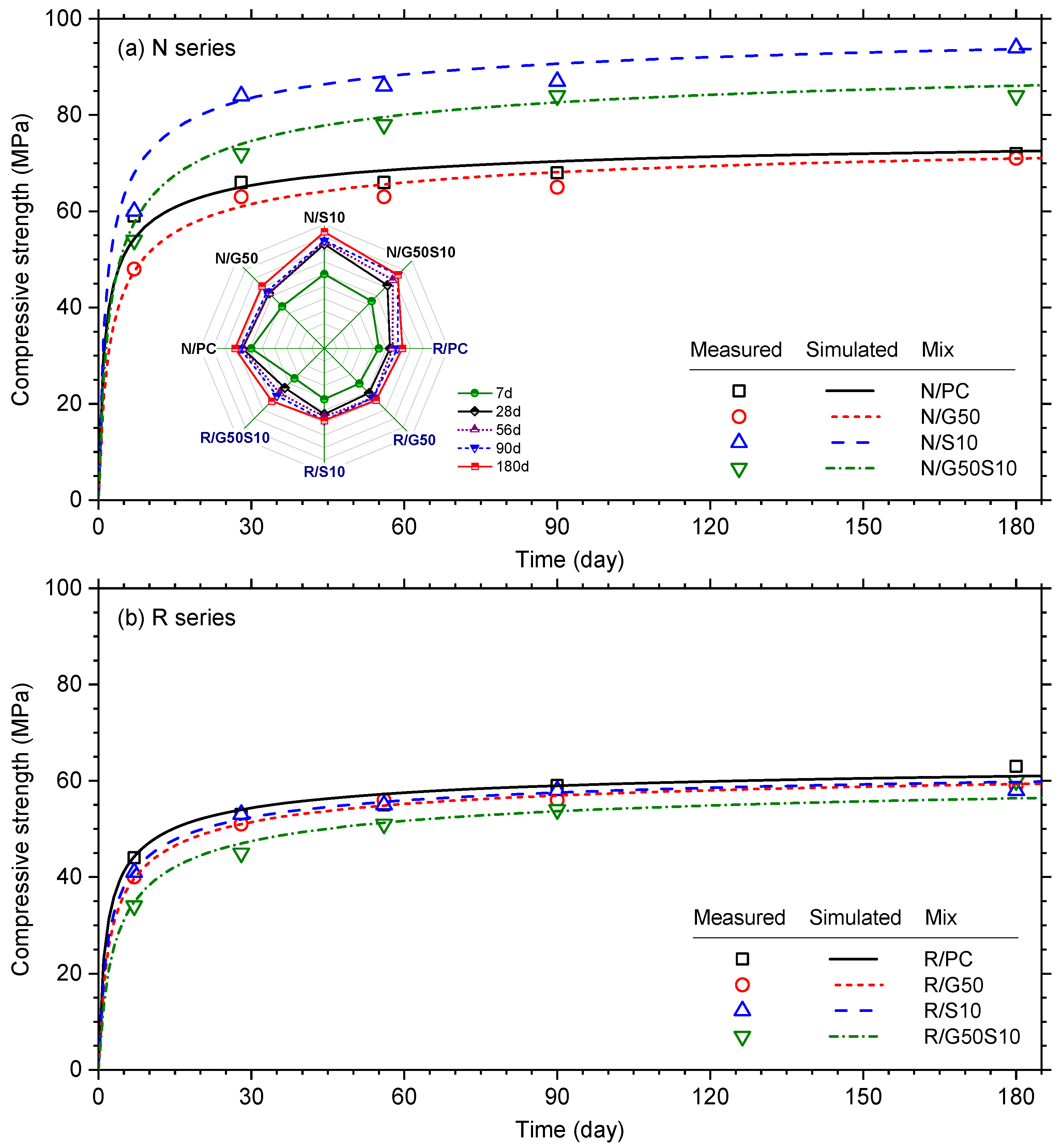
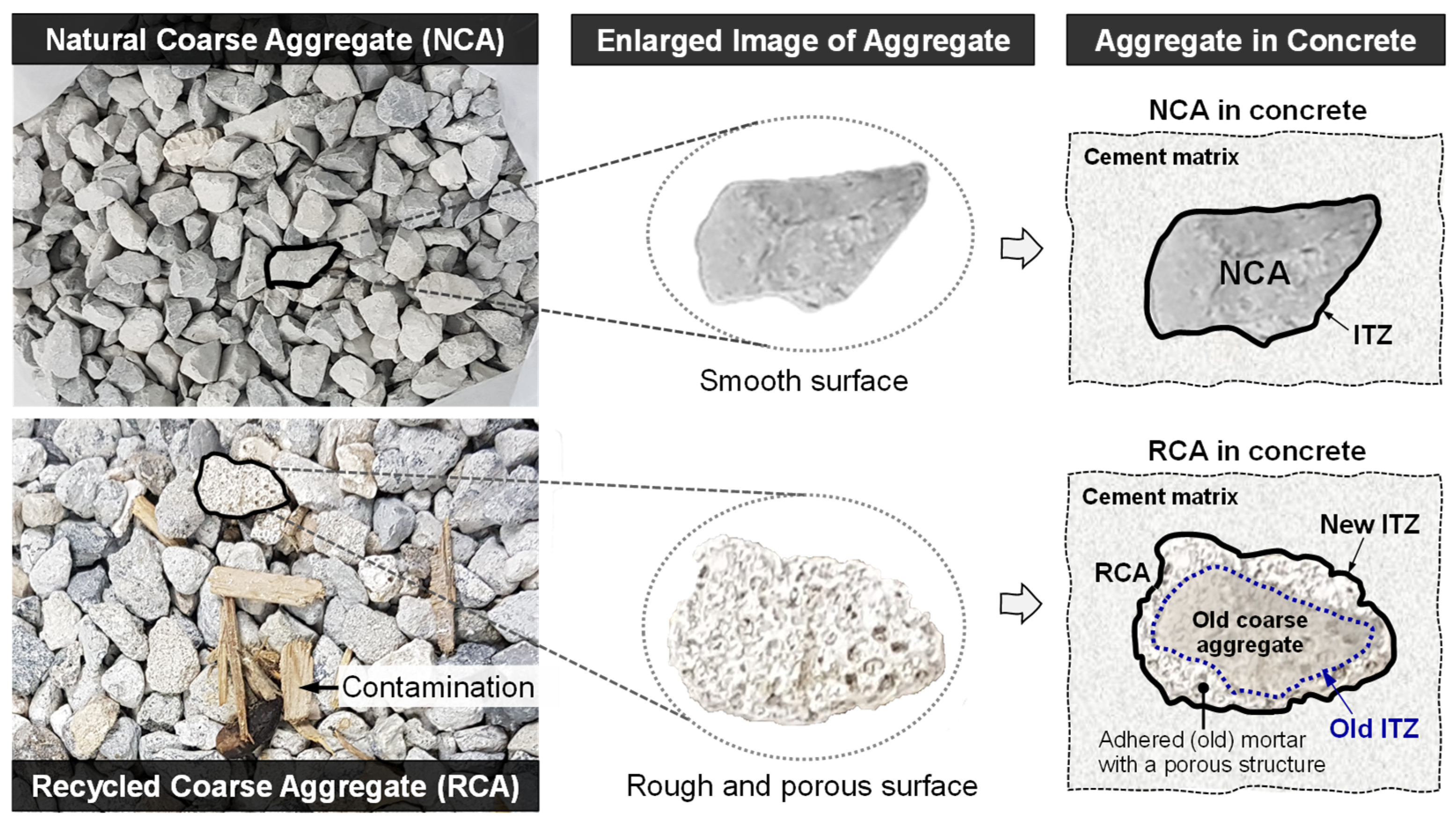
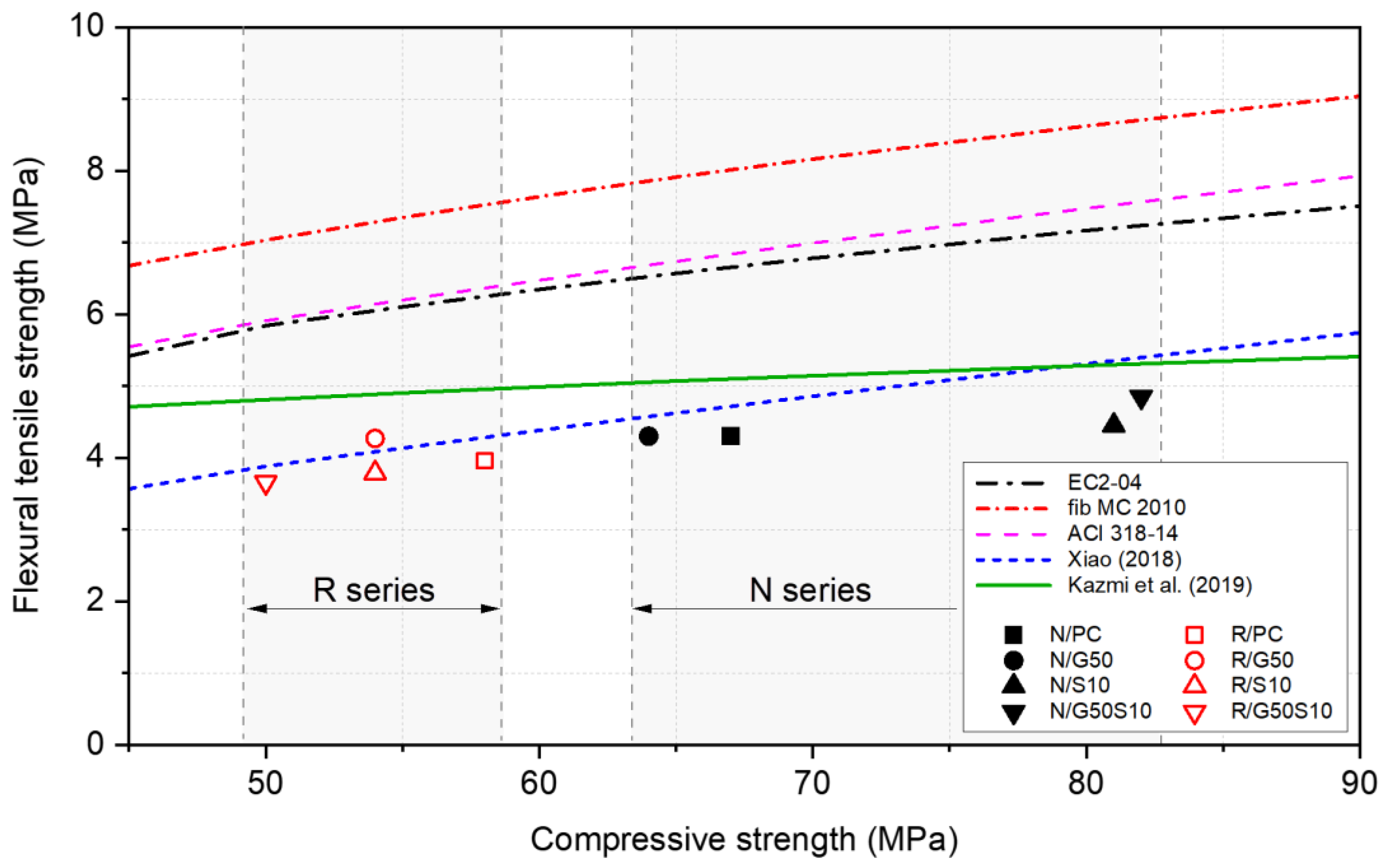

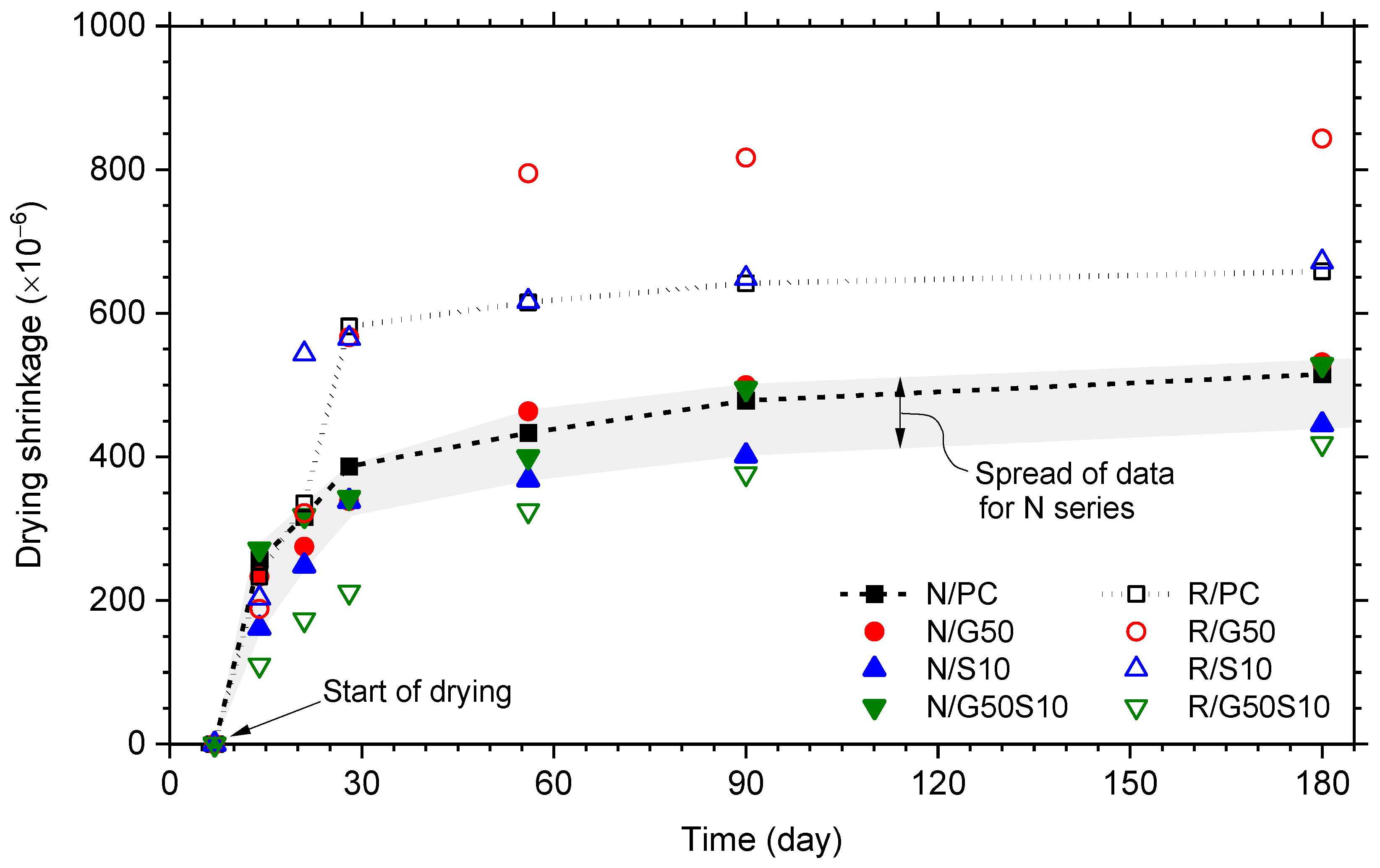

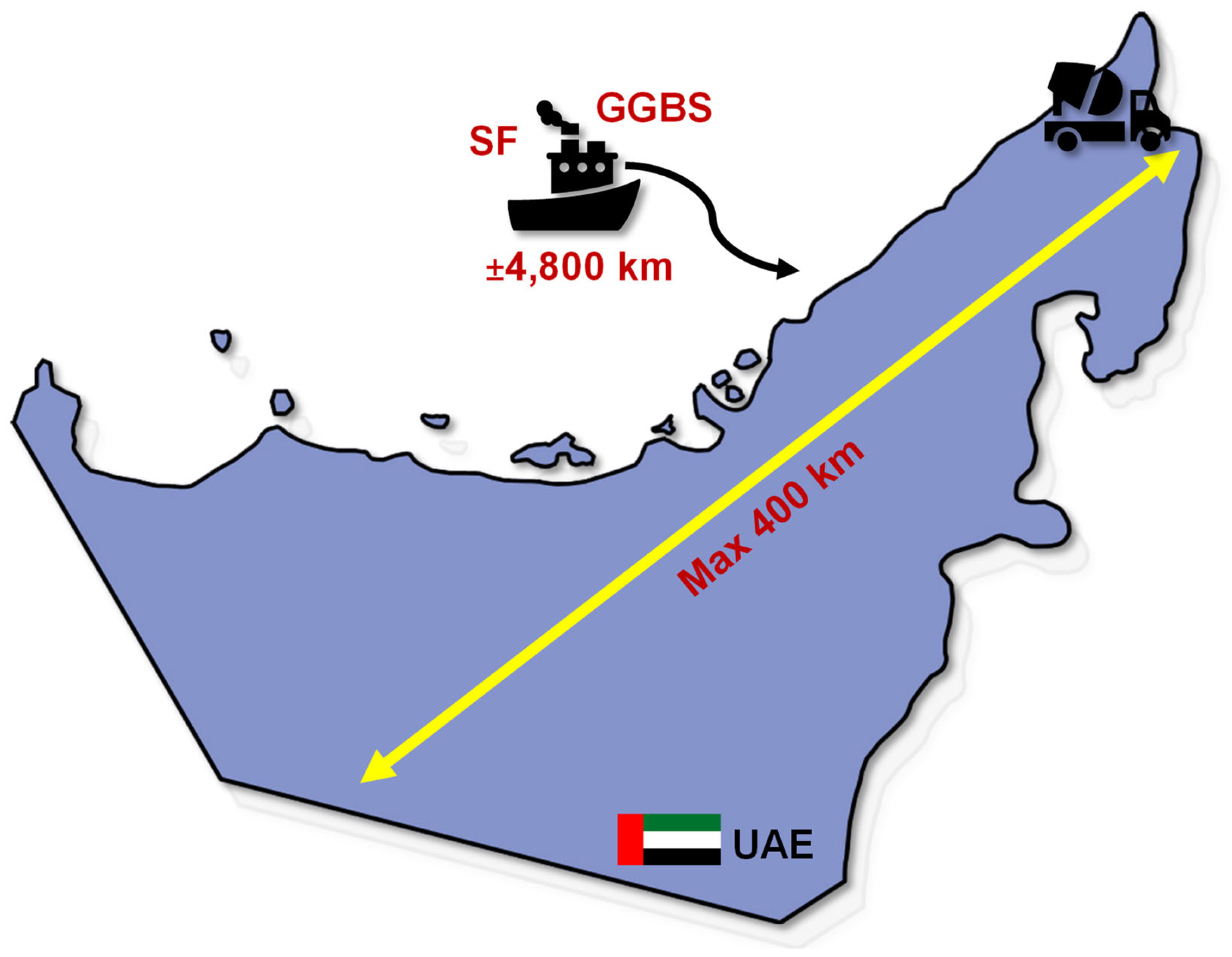

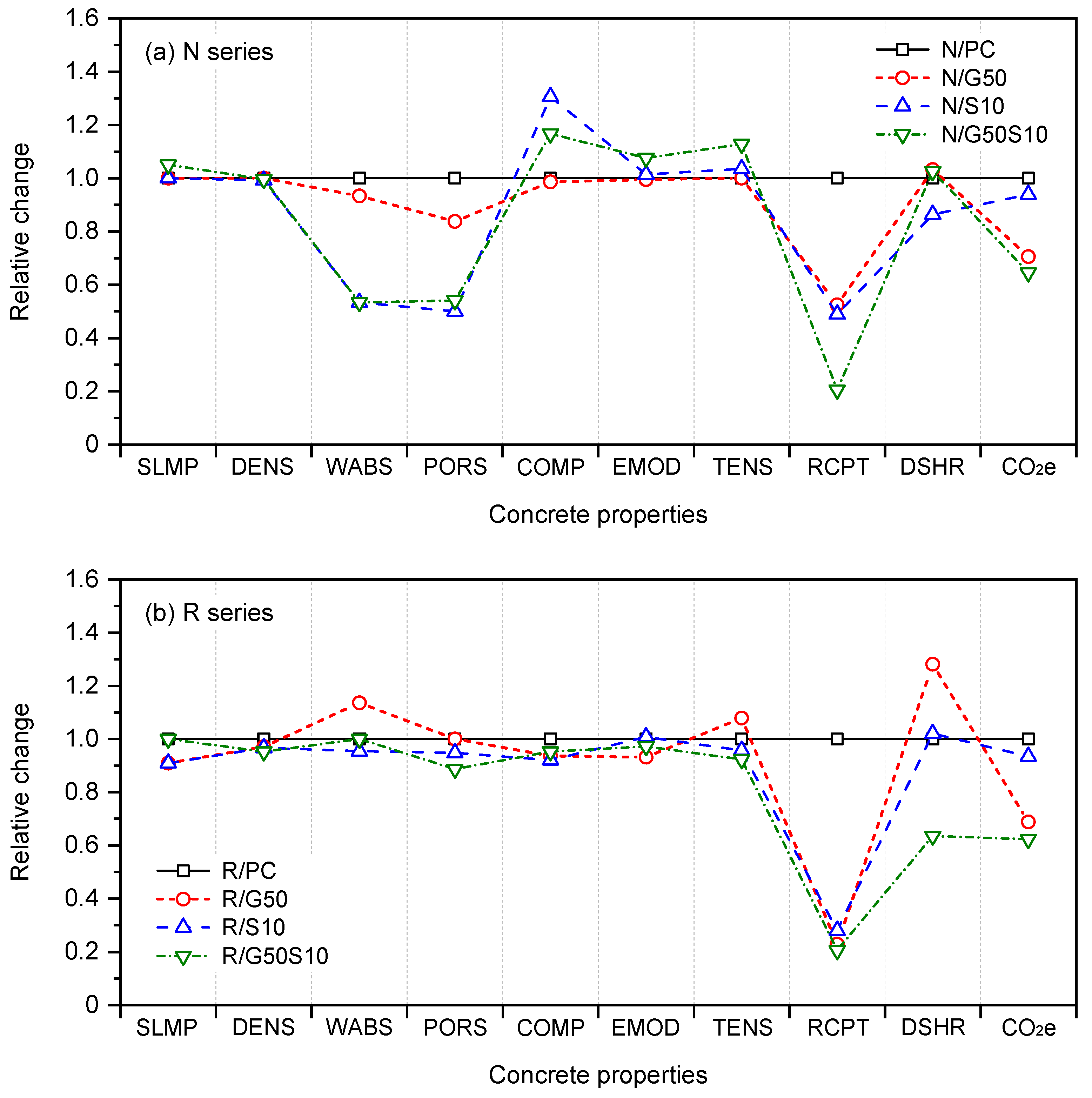
| Property | Values from Prior Studies [17,20,21,22,23,24,25,26,27,28,29,30,31,32,33,34,35,36,37,38,39,40,41,42,43,44,45,46,47,48] | Limits from Standards |
|---|---|---|
| Specific gravity | 2.3–2.47 | >2.1 [48] |
| Bulk density (compacted) | 1.1–1.35 | <2 [51] |
| Water absorption | 3.1–12% | <7% [48] |
| Flakiness index | <17% | <35% [50] |
| Elongation index | <20% | <35% [50] |
| Acid soluble sulphate | <0.14% | <0.8% [48] |
| Acid soluble chloride | <0.3% | <0.05% [49] |
| LA abrasion value | 25–42% | <40% [48] |
| Ten percent fines value (kN) | 120–160 | >80 [48] |
| ID | Description |
|---|---|
| N/PC | Crushed limestone, normal coarse aggregate (NCA) concrete with plain Portland cement binder |
| N/G50 | NCA concrete with 50% replacement of the cement with GGBS |
| N/S10 | NCA concrete with 10% replacement of the cement with silica fume |
| N/G50S10 | NCA concrete with 60% replacement of the cement with GGBS (50%) and silica fume (10%) |
| R/PC | Recycled coarse aggregate (RCA) concrete with plain Portland cement binder |
| R/G50 | RCA concrete with 50% replacement of the cement with GGBS |
| R/S10 | RCA concrete with 10% replacement of the cement with silica fume |
| R/G50S10 | RCA concrete with 60% replacement of the cement with GGBS (50%) and silica fume (10%) |
| Mix Designation | CEM I kg/m3 | GGBS kg/m3 | SF kg/m3 | NCA 20 mm kg/m3 | NCA 10 mm kg/m3 | RCA 5/14 mm kg/m3 | Fine <5 mm kg/m3 | Dune Sand kg/m3 |
|---|---|---|---|---|---|---|---|---|
| N/PC | 400 | – | – | 553 | 368 | – | 718 | 308 |
| N/G50 | 200 | 200 | – | 553 | 368 | – | 718 | 308 |
| N/S10 | 360 | – | 40 | 553 | 368 | – | 718 | 308 |
| N/G50S10 | 160 | 200 | 40 | 553 | 368 | – | 718 | 308 |
| R/PC | 400 | – | – | – | – | 735 | 846 | 362 |
| R/G50 | 200 | 200 | – | – | – | 735 | 846 | 362 |
| R/S10 | 360 | – | 40 | – | – | 735 | 846 | 362 |
| R/G50S10 | 160 | 200 | 40 | – | – | 735 | 846 | 362 |
| % by Weight | CEM I | GGBS | SF |
|---|---|---|---|
| CaO | 63.92 | 41.97 | + |
| SiO2 | 20.09 | 31.23 | 90 |
| Al2O3 | 4.75 | 12.75 | + |
| Fe2O3 | 3.45 | 1.04 | + |
| MgO | 1.47 | 4.45 | + |
| P2O5 | 0.02 | 0 | + |
| Na2O | 0.14 | 0.2 | + |
| K2O | 0.55 | 0.23 | + |
| SO3 | 2.2 | 1.08 | + |
| Clˉ | 0.05 | 0.02 | + |
| MnO | + | 0.12 | + |
| Mn2O3 | + | 0.27 | + |
| TiO2 | + | 0.77 | + |
| SrO | + | 0.08 | + |
| CaCO3 | + | + | + |
| LOI | 3.0 | 2.12 | 2.23 |
| Origin | Dubai | China | China |
| Properties | Unit | NCA 20 mm | NCA 10 mm | Fine < 5 mm | Dune Sand | RCA 5–14 mm | Recommended Values for RCA |
|---|---|---|---|---|---|---|---|
| SG (oven dry) | 2.67 | 2.67 | 2.61 | 2.59 | 2.36 | ≥2.1 [48] | |
| SG (SSD) | 2.68 | 2.68 | 2.65 | 5.62 | 2.48 | – | |
| Apparent SG | 2.70 | 2.71 | 2.72 | 2.68 | 2.69 | – | |
| Water absorption | % | 0.5 | 0.5 | 1.6 | 1.2 | 5.1 | ≤7 [48] |
| Bulk density (compacted) | ×103 kg/m3 | 1.50 | 1.49 | 1.51 | 1.66 | 1.35 | ≤2 [51] |
| Bulk density (uncompacted) | ×103 kg/m3 | 1.40 | 1.38 | 1.34 | 1.54 | 1.25 | – |
| Flakiness index | % | 9 | 22 | + | + | 19 | <35 [50] |
| Elongation index | % | 24 | 23 | + | + | 15 | <35 [50] |
| Acid soluble sulphate | % | 0.03 | 0.04 | 0.03 | 0.02 | 0.21 | <0.80 [48] |
| Acid soluble chloride | % | 0.01 | 0.01 | 0.01 | 0.01 | 0.02 | <0.05 [49] |
| Aggregates impact | % | 28 | 24 | + | + | 24 | – |
| LA abrasion | % | 28 | 24 | + | + | 28 | <40 [48] |
| Aggregates crushing | % | 26 | 23 | + | + | 23 | <45 [52] |
| Ten percent fines | kN | 160 | 180 | + | + | 190 | ≥80 [48] |
| Moisture content | % | 0.1 | 0.1 | 4.7 | 1.0 | 1.5 | – |
| Soundness | % | 1.1 | 2 | 6 | + | 6 | <10 [48] |
| Mix Designation | Slump | Density | Porosity | Water Absorption |
|---|---|---|---|---|
| mm | kg/m3 | % | % | |
| N/PC | 200 | 2480 | 7.4 | 1.5 |
| N/G50 | 200 | 2480 | 6.2 | 1.4 |
| N/S10 | 200 | 2460 | 3.7 | 0.8 |
| N/G50S10 | 210 | 2470 | 4.0 | 0.8 |
| R/PC | 220 | 2410 | 11.5 | 2.2 |
| R/G50 | 200 | 2340 | 11.5 | 2.5 |
| R/S10 | 200 | 2330 | 10.9 | 2.1 |
| R/G50S10 | 220 | 2294 | 10.2 | 2.2 |
| Mix Designation | Cube | Cylinder | Cylinder/Cube | ||||||
|---|---|---|---|---|---|---|---|---|---|
| F7 MPa | F28 MPa | F56 MPa | F90 MPa | F180 MPa | f28 MPa | f90 MPa | f28/F28 | f90/F90 | |
| N/PC | 59 | 66 | 66 | 68 | 72 | 63 | 67 | 0.95 | 0.99 |
| N/G50 | 48 | 63 | 63 | 65 | 71 | 51 | 64 | 0.81 | 0.98 |
| N/S10 | 60 | 84 | 86 | 87 | 94 | 83 | 81 | 0.99 | 0.93 |
| N/G50S10 | 54 | 72 | 78 | 84 | 84 | 71 | 82 | 0.99 | 0.98 |
| Mix Designation | Cube | Cylinder | Cylinder/Cube | ||||||
|---|---|---|---|---|---|---|---|---|---|
| F7 MPa | F28 MPa | F56 MPa | F90 MPa | F180 MPa | f28 MPa | f90 MPa | f28/F28 | f90/F90 | |
| R/PC | 44 | 53 | 55 | 59 | 63 | 41 | 58 | 0.77 | 0.98 |
| R/G50 | 40 | 51 | 56 | 56 | 59 | 47 | 54 | 0.92 | 0.96 |
| R/S10 | 41 | 53 | 55 | 58 | 58 | 45 | 54 | 0.85 | 0.93 |
| R/G50S10 | 34 | 45 | 51 | 54 | 60 | 44 | 50 | 0.98 | 0.93 |
| Mix Designation | Parameter | |
|---|---|---|
| (MPa) | ||
| N/PC | 65 | 0.18 |
| N/G50 | 61 | 0.25 |
| N/S10 | 83 | 0.20 |
| N/G50S10 | 74 | 0.25 |
| R/PC | 54 | 0.20 |
| R/G50 | 51 | 0.25 |
| R/S10 | 52 | 0.23 |
| R/G50S10 | 47 | 0.30 |
| Mix | Modulus of Elasticity | Flexural Tensile Strength | ||
|---|---|---|---|---|
| (GPa) | (MPa) | |||
| 28 Days | 90 Days | 28 Days | 90 Days | |
| N/PC | 43.3 | 43.7 | 3.82 | 4.30 |
| N/G50 | 43.0 | 42.8 | 3.86 | 4.30 |
| N/S10 | 43.9 | 45.2 | 4.05 | 4.45 |
| N/G50S10 | 46.5 | 46.5 | 4.37 | 4.85 |
| R/PC | 28.8 | 34.3 | 3.44 | 3.96 |
| R/G50 | 26.9 | 31.1 | 3.95 | 4.27 |
| R/S10 | 29.1 | 31.0 | 3.61 | 3.79 |
| R/G50S10 | 28.0 | 28.2 | 3.51 | 3.66 |
| Reference | Tensile Strength Equation | Equation Number |
|---|---|---|
| EC2-04 [97] | The flexural tensile strength can be computed as | (2) |
where h is the beam depth (mm) | (3) | |
| fib MC 2010 [110] | The flexural tensile strength can be computed as | (4) |
where is the beam depth (mm); = 0.06 | (5) | |
| ACI 318-14 [111] | The conversion factor from tensile strength to flexural strength is 0.67. | (6) |
| Xiao (2018) [20] | where r is the replacement ratio of RCA | (7) |
| Kazmi et al. (2019) [109] | (8) |
| Material | Embodied Carbon (kgCO2e per Tonne of Material) | |
|---|---|---|
| Without Transportation in the UAE | With Transportation in the UAE | |
| OPC | 709 | 745 |
| GGBS | 121 | 157 |
| SF | 96 | 132 |
| Coarse aggregate | 46 | 82 |
| Fine aggregate | 14 | 50 |
| Recycle coarse aggregate | 22 | 58 |
Disclaimer/Publisher’s Note: The statements, opinions and data contained in all publications are solely those of the individual author(s) and contributor(s) and not of MDPI and/or the editor(s). MDPI and/or the editor(s) disclaim responsibility for any injury to people or property resulting from any ideas, methods, instructions or products referred to in the content. |
© 2025 by the authors. Licensee MDPI, Basel, Switzerland. This article is an open access article distributed under the terms and conditions of the Creative Commons Attribution (CC BY) license (https://creativecommons.org/licenses/by/4.0/).
Share and Cite
Mouna, Y.; Suryanto, B. Recycled Aggregate Concrete: Effect of Supplementary Cementitious Materials and Potential for Supporting Sustainable Construction. Materials 2025, 18, 5183. https://doi.org/10.3390/ma18225183
Mouna Y, Suryanto B. Recycled Aggregate Concrete: Effect of Supplementary Cementitious Materials and Potential for Supporting Sustainable Construction. Materials. 2025; 18(22):5183. https://doi.org/10.3390/ma18225183
Chicago/Turabian StyleMouna, Yara, and Benny Suryanto. 2025. "Recycled Aggregate Concrete: Effect of Supplementary Cementitious Materials and Potential for Supporting Sustainable Construction" Materials 18, no. 22: 5183. https://doi.org/10.3390/ma18225183
APA StyleMouna, Y., & Suryanto, B. (2025). Recycled Aggregate Concrete: Effect of Supplementary Cementitious Materials and Potential for Supporting Sustainable Construction. Materials, 18(22), 5183. https://doi.org/10.3390/ma18225183







